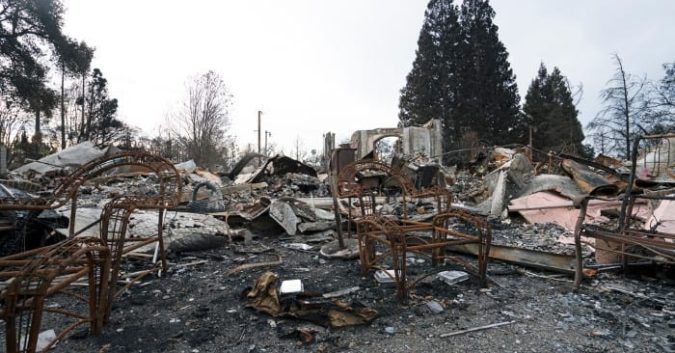The 2018 fire season is the most destructive in California since records have been kept. Thousands of families are still displaced after their homes and towns were burned to the ground in the wildfires, which covered an estimated 1.6 million acres. Nearly 100 people have been killed, including 6 firefighters.
Many of the wildfires are now contained, but some residents have been barred from returning to their homes. With towns and forests razed to the ground, officials worry there is an increased risk of mudslides, which could easily lead to more fatalities. Downed electric lines and unstable structures also pose a significant hazard, until they have been cleared.
In addition to these immediate concerns, both authorities and residents must also contend with the long-term hazards of structures destroyed by fire. In short, fires leave behind hazardous waste, like asbestos and other toxins. Firefighters, first responders, hazardous waste workers, and eventually residents are all at risk of exposure.
Toxins in Household Items and Structures Released During Fire
Everyday items, such as batteries, televisions, cookware, and thermometers all contain toxins, which are released during a fire. Pressure treated wood, which is still used in homes, releases a host of deadly poisons when it is burned.
As entire Californian cities went up in flames, toxic smoke and ash posed a serious risk to first responders and those trying to flee. The blaze consumed entire industrial and commercial properties and their stockpiles of chemicals. The Woolsey fire even spread through the Santa Susana Field Laboratory, a former nuclear and rocket engine testing site in southern California. Officials have cleared any immediate danger, but not all scientists are convinced.
Prevalence of Asbestos in California Structures Intensifies Risks after Wildfire
Because California was the site of so much asbestos mining and manufacturing, it was widely used as a cheap and durable material in the siding, insulation, and roofing of many structures built before the 1980s. Asbestos is no longer used because inhaled asbestos fibers cause mesothelioma, an incurable and lethal form of cancer. California has the highest number of asbestos related fatalities in the country, with 21,338 deaths in the last 15 years.
As workers clear the rubble and search for those who are still missing, debris continues to smolder and the work takes place amidst the windblown ash. “Even a few fibers of asbestos could be a health impact,” Dr. Linda Smith of the California Air Resources Board (CARB) told The New York Times.
CARB is part of the California Environmental Protection Agency tasked with reducing contaminants in the air in the interest of public health. Because of the dangers of mesothelioma and asbestosis, CARB enforces very strict standards when it comes to demolishing buildings with asbestos. Contractors who try to dodge asbestos regulations end up exposing workers and their families to the poisonous fibers.
Even when done carefully, the removal of asbestos from buildings is risky. The fire demolished thousands of buildings without a plan or purpose. Strong winds and flood waters scattered hazardous materials across the landscape. Now that the flames have died down, it is time to focus on a safe clean up.
The task is as big as it is important to get right. Disaster response of this magnitude is going to cost a lot of money, and that money must be spent wisely. Enough resources need to be put aside for both the heroes who responded to the catastrophic fires and the residents who long to rebuild their homes.
Squandered Resources in Past Wildfire Call for Renewed Scrutiny of Clean Up
After fires destroyed 4,500 homes in Santa Rosa in 2017, the U.S. Army Corps of Engineers hired independent contractors to haul away debris. Without much oversight, certain contractors further damaged properties, did not monitor their cleanup, and billed the U.S. government for millions in unnecessary cleanup.
This cannot be allowed to happen again.
Both state and federal resources are once again stretched thin by the record-setting destruction. One of the largest clean-ups in history is now underway. The vast sums involved with largescale clean-up are going to draw a lot of attention from companies, good and bad. Oversight will be difficult across burn areas that span close to 2 million acres. The conditions are ripe for some unethical companies to cut corners and expose Californian residents to years of increased risk.
For those who know the dangers of asbestos exposure, the time to speak up is now. Even those who are not residents of California should be vocal in making sure a close eye is kept on the cleanup.
